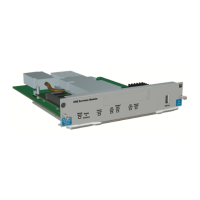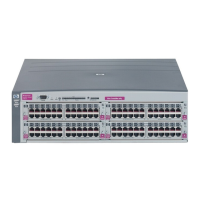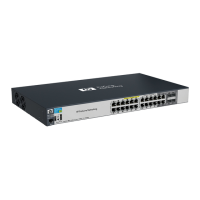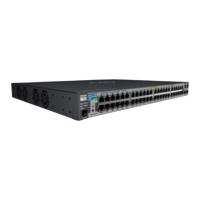B-6
Cabling and Technology Information
Twisted-Pair Cable/Connector Pin-Outs
Cabling and Technology
Information
Twisted-Pair Cable/Connector Pin-Outs
The HP Auto-MDIX Feature. In the default configuration, “Auto”, the
10/100Base-TX ports on the 10/100-TX and PoE xl Modules used in the Series
5400zl Switches all automatically detect the type of port on the connected
device and operate as either an MDI or MDI-X port, whichever is appropriate.
So for any connection, a straight-through twisted-pair cable can be used -- you
no longer have to use crossover cables, although crossover cables can also be
used for any of the connections. The 100/1000-T xl Module supports the IEEE
802.3ab standard, which includes the “Auto MDI/MDI-X” feature, which oper
-
ates the same way.
Note HP Auto-MDIX was developed and shared with the IEEE for the development
of the IEEE 802.3ab standard. HP Auto-MDIX and the IEEE 802.3ab Auto MDI/
MDI-X feature are completely compatible.
If you connect a Series 5400zl Switch twisted-pair port to another switch or
hub, which typically have MDI-X ports, the Series 5400zl Switch port automat
-
ically operates as an MDI port. If you connect it to an end node, such as a
server or PC, which typically have MDI ports, the Series 5400zl Switch port
operates as an MDI-X port. In all cases, you can use standard straight through
cables.
If you happen to use a correctly wired crossover cable, though, the switch will
still be able to automatically detect the MDI/MDI-X operation and link
correctly to the connected device.
If the port configuration is changed to any of the fixed configurations
though, for example 100 Mbps/full duplex, the port operates as MDI-X only
and the correct cable type must be used. In general, for connections to MDI
ports, such as end nodes, use a straight-through cable; for connections to MDI-
X ports, such as on hubs and other switches, use a crossover cable.
Other Wiring Rules:
■ All twisted-pair wires used for 10 Mbps, and 100 Mbps operation must be
twisted through the entire length of the cable. The wiring sequence must
conform to EIA/TIA 568-B (not USOC). See the Pin Assignment tables
below the cable illustrations later in this appendix for a listing of the
signals used on each pin.
■ For 1000Base-T connections, all four pairs of wires in the cable must be
available for data transmission. See “Note on 1000Base-T Cable Require
-
ments” on page B-1 for more information on 1000Base-T cabling.
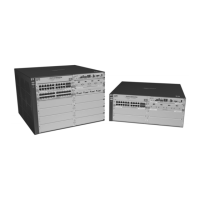
